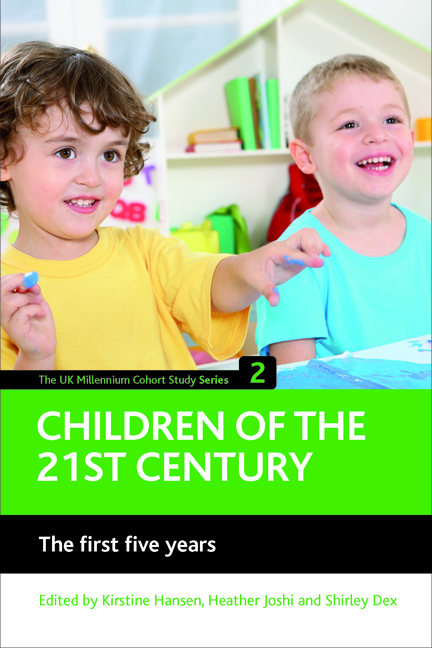Book contents
- Frontmatter
- Contents
- Acknowledgements
- List of contributors
- Glossary
- one Introduction
- two Child poverty in the first five years of life
- three Ethnicity, community and social capital
- four Parental relationships and parenting
- five Partnership trajectories, parent and child well-being
- six Employment trajectories and ethnic diversity
- seven Neighbourhoods and residential mobility
- eight Childcare in the pre-school years
- nine Intergenerational inequality in Early Years assessments
- ten Ethnic inequalities in child outcomes
- eleven School choice
- twelve Teacher assessments in the first year of school
- thirteen Childhood overweight and obesity
- fourteen Resilience in children's development
- fifteen Parental and child health
- sixteen Conclusions
- References
three - Ethnicity, community and social capital
Published online by Cambridge University Press: 01 September 2022
- Frontmatter
- Contents
- Acknowledgements
- List of contributors
- Glossary
- one Introduction
- two Child poverty in the first five years of life
- three Ethnicity, community and social capital
- four Parental relationships and parenting
- five Partnership trajectories, parent and child well-being
- six Employment trajectories and ethnic diversity
- seven Neighbourhoods and residential mobility
- eight Childcare in the pre-school years
- nine Intergenerational inequality in Early Years assessments
- ten Ethnic inequalities in child outcomes
- eleven School choice
- twelve Teacher assessments in the first year of school
- thirteen Childhood overweight and obesity
- fourteen Resilience in children's development
- fifteen Parental and child health
- sixteen Conclusions
- References
Summary
Introduction
This chapter focuses on indicators of social capital in the lives of the mothers of the Millennium Cohort Study (MCS) children. The mothers’ social networks, social support and experiences of their local areas will be relevant to their children as they grow up. The concept of social capital has been influential in policy circles, but is contested, and has been used for varying purposes by social theorists. For Coleman, social capital refers to ‘the set of resources that inhere in family relations and in community social organisation and that are useful for the cognitive or social development of a child or young person’ (Coleman, 1994, p 300). Social capital in the family consists of the time and attention given to the child by family members, while social capital within the school and the community consists of social networks that allow social norms to be established and enforced (Coleman, 1988). For Putnam, social capital describes ‘features of social organisation, such as trust, norms and networks’ (Putnam, 1993, p 167). Putnam is particularly concerned with a perceived decline in sociability, associational life and political participation. He uses a wide range of measures of social capital, including measures of community organisational life, engagement in public affairs, community voluntarism, informal sociability and social trust (Schuller et al, 2000). As such, he has been criticised for overstretching the concept of social capital (Portes, 1998).
Social capital has been seen as particularly important for minority ethnic groups, because economic disadvantages, and even a lack of education, may be counterbalanced by high levels of social capital within the home and community (Lauglo, 2000). It may be possible, therefore, for minority ethnic communities who are economically disadvantaged still to promote high educational aspirations and educational success within their community (Gibson, 2000; Portes and Rumbaut, 2001). Conversely, the ability of strongly bonded social groups to enforce social norms can have negative consequences if anti-achievement norms prevail within such groups. Portes and Rumbaut put forward a model of ‘segmented assimilation’, suggesting that assimilation of immigrant groups into the norms of the native community is not always positive. Strong minority ethnic communities and families can act together to protect children against ‘downward assimilation’ into the under-class norms of gangs, crime, teen pregnancy and resistance or indifference to schooling.
- Type
- Chapter
- Information
- Children of the 21st century (Volume 2)The First Five Years, pp. 33 - 52Publisher: Bristol University PressPrint publication year: 2010

